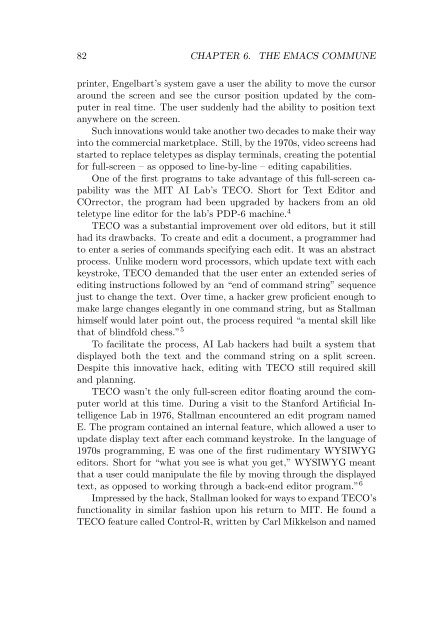Create successful ePaper yourself
Turn your PDF publications into a flip-book with our unique Google optimized e-Paper software.
82 CHAPTER 6. THE EMACS COMMUNE<br />
printer, Engelbart’s system gave a user the ability to move the cursor<br />
around the screen and see the cursor position updated by the computer<br />
in real time. The user suddenly had the ability to position text<br />
anywhere on the screen.<br />
Such innovations would take another two decades to make their way<br />
into the commercial marketplace. Still, by the 1970s, video screens had<br />
started to replace teletypes as display terminals, creating the potential<br />
for full-screen – as opposed to line-by-line – editing capabilities.<br />
One of the first programs to take advantage of this full-screen capability<br />
was the MIT AI Lab’s TECO. Short for Text Editor and<br />
COrrector, the program had been upgraded by hackers from an old<br />
teletype line editor for the lab’s PDP-6 machine. 4<br />
TECO was a substantial improvement over old editors, but it still<br />
had its drawbacks. To create and edit a document, a programmer had<br />
to enter a series of commands specifying each edit. It was an abstract<br />
process. Unlike modern word processors, which update text with each<br />
keystroke, TECO demanded that the user enter an extended series of<br />
editing instructions followed by an “end of command string” sequence<br />
just to change the text. Over time, a hacker grew proficient enough to<br />
make large changes elegantly in one command string, but as Stallman<br />
himself would later point out, the process required “a mental skill like<br />
that of blindfold chess.” 5<br />
To facilitate the process, AI Lab hackers had built a system that<br />
displayed both the text and the command string on a split screen.<br />
Despite this innovative hack, editing with TECO still required skill<br />
and planning.<br />
TECO wasn’t the only full-screen editor floating around the computer<br />
world at this time. During a visit to the Stanford Artificial Intelligence<br />
Lab in 1976, Stallman encountered an edit program named<br />
E. The program contained an internal feature, which allowed a user to<br />
update display text after each command keystroke. In the language of<br />
1970s programming, E was one of the first rudimentary WYSIWYG<br />
editors. Short for “what you see is what you get,” WYSIWYG meant<br />
that a user could manipulate the file by moving through the displayed<br />
text, as opposed to working through a back-end editor program.” 6<br />
Impressed by the hack, Stallman looked for ways to expand TECO’s<br />
functionality in similar fashion upon his return to MIT. He found a<br />
TECO feature called Control-R, written by Carl Mikkelson and named


